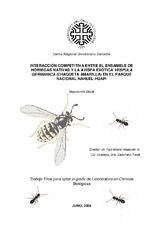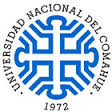- RDI Principal
- →
- Centro Regional Universitario Bariloche
- →
- Tesis de Grado
- →
- Ver ítem
JavaScript is disabled for your browser. Some features of this site may not work without it.
Mostrar el registro sencillo del ítem
| dc.contributor.advisor | Farji-Brener, Alejandro | es_ES |
| dc.contributor.other | Sackmann, Paula | es_ES |
| dc.coverage.spatial | ARG | es_ES |
| dc.creator | Masciocchi, Maité | |
| dc.date | 2008-06-12 | |
| dc.date.accessioned | 2021-03-16T15:07:02Z | |
| dc.date.available | 2021-03-16T15:07:02Z | |
| dc.identifier | http://rdi.uncoma.edu.ar/handle/uncomaid/16152 | |
| dc.description.abstract | El éxito relativo de las invasiones biológicas puede depender, en parte, de las interacciones con las especies nativas. Una de las invasiones más reciente ocurridas en el NO de la Patagonia es la de la avispa exótica Vespula germanica. Sin embargo, se desconoce como interactúa con el ensamble nativo de hormigas, con el cual comparte hábitat y recursos alimenticios. Determiné, de forma experimental, la existencia de interacciones competitivas entre el ensamble nativo de hormigas del NO de la Patagonia y la avispa exótica Vespula germanica. Analicé si la magnitud y dirección de la competencia dependía de la composición del ensamble de hormigas, el tipo de hábitat, y el tipo de alimento. Seleccioné sitios dentro del Parque Nacional Nahuel Huapi en los hábitats de bosque y matorral. En cada sitio coloqué tapas plásticas, con cebo proteico o con cebo de hidratos de carbono. A cada tipo de cebo lo coloqué bajo 3 niveles de tratamiento de exclusión: exclusión de avispas, exclusión de hormigas y control (o sea, libre acceso de avispas y hormigas). Los cebos proteicos fueron los únicos atractivos tanto para avispas como para hormigas. La exclusión de hormigas de los cebos incrementó la abundancia de avispas respecto al control, pero la exclusión de avispas de los cebos no afectó el número de hormigas respecto al control. Este patrón se observó tanto en el bosque como en el matorral. Esto sugiere la existencia de competencia asimétrica, en donde las hormigas nativas afectan negativamente la actividad y abundancia de V. germanica, pero la avispa no afecta negativamente a las hormigas. La superioridad competitiva de las hormigas podría deberse a su comportamiento agresivo y a la agregación de muchos individuos sobre los recursos alimenticios. Esta interacción, sumada a otros factores, podría limitar la abundancia y/o la expansión de Vespula germanica en determinadas áreas de la Patagonia. Este trabajo podría considerarse como un ejemplo de resistencia biótica. | es_ES |
| dc.description.abstract | The success of a biological invasion may depend, in part, on the interactions of the invader with native species. One of the most recent invasions in NW Patagonia is the one of the exotic wasp Vespula germanica. However, little is known about how the wasp interacts with native ants, with which it shares the habitat and food resources. I experimentally determined the existence of a competitive interaction between the local ant assemblages of NW Patagonia and the exotic wasp Vespula germanica. I explored whether the magnitude and direction of this interaction is affected by the composition of the ant assemblage, the kind of habitat, and the type of food. I selected sites within the Nahuel Huapi National Park in forest and scrubland habitats. At each site, I placed plastic discs, with protein or carbohydrate bait. Each bait type was placed under 3 treatment levels: wasp exclusion, ant exclusion and control (i. e., free access for the wasps and ants). Protein baits were the only bait type that attracted both wasps and ants. The exclusion of ants from the baits increased the number of wasps compared to the control, but the exclusion of wasps did not affect the number of ants compared with the control. This pattern was observed both in the forest and in scrub habitats. This suggests the existence of asymmetric competition, in which native ants affect the exotic wasp but not vice versa. The competitive dominance of ants could be due to their aggressiveness and the high aggregation of individual ants on baits that physically limit the access of wasps to them. This interaction, among other factors, could limit the abundance and distribution of this exotic wasp in certain areas of Patagonia. This work could be considered an example of biotic resistance | |
| dc.format | application/pdf | es_ES |
| dc.language | spa | es_ES |
| dc.publisher | Universidad Nacional del Comahue. Centro Regional Universitario Bariloche | es_ES |
| dc.rights | Atribución-NoComercial-CompartirIgual 2.5 Argentina | es_ES |
| dc.rights.uri | https://creativecommons.org/licenses/by-nc-sa/2.5/ar/ | es_ES |
| dc.subject | Avispas sociales | es_ES |
| dc.subject | Resistencia biótica | es_ES |
| dc.subject | Ecología | es_ES |
| dc.subject | Invasión biológica | es_ES |
| dc.subject.other | Ciencias Agrarias y Forestales | es_ES |
| dc.title | Interacción competitiva entre el ensamble de hormigas nativas y la avispa exótica vespula germanica (chaqueta amarilla) en el Parque Nacional Nahuel Huapi | es_ES |
| dc.type | TesisdeGrado | es |
| dc.type | bachelorThesis | eu |
| dc.type | acceptedVersion | eu |
| unco.tesis.grado | Licenciada en Ciencias Biológicas | es_ES |
| dc.description.fil | Fil: Masciocchi, Maité. Universidad Nacional del Comahue. Centro Regional Universitario Bariloche; Argentina. | es_ES |
| dc.cole | Tesis de Grado |



